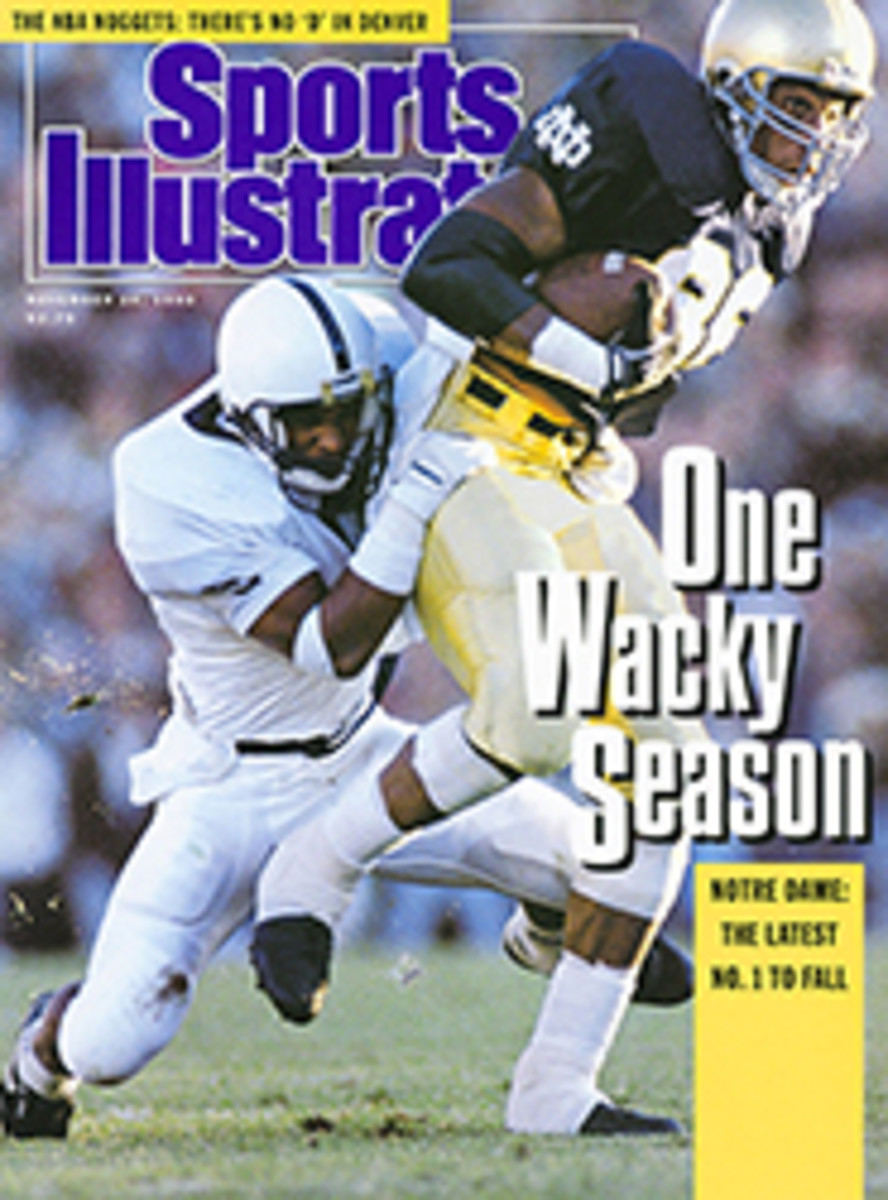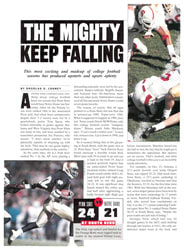
MAN WITH THE WORLD ON A STRING
On his best day, yo-yo legend Harvey Lowe can't sling more than six straight around-the-worlds. Even the world's top performer, Dale Myrberg, can't coax many more from his favorite yo-yo. But Tom Kuhn, a San Francisco dentist, can zip off 40 revolutions faster than you can say, "Yo!" In fact, Kuhn once threw 102 around-the-worlds and still had enough zip left to yank the whizzing spool back to his hand.
Kuhn, 47, who moonlights as a yo-yo maker, has a secret, though. It is his newest creation: the SB-2 (short for Silver Bullet 2), an aircraft-aluminum model equipped with a ball-bearing axle.
While it won't alter Newtonian physics, the SB-2 could throw the yo-yo world for a loop. You see, the SB-2 can spin at the end of the string—or, in yo-yo talk, sleep—for 90 seconds; conventional models can muster about 15 seconds. And nothing is more critical to competition players than stretching their spins, because that yields more time in which to shoot the moon, rock the baby and thread the needle.
"[SB-2] is a quantum leap in yo-yo technology," says Stuart Crump Jr., the editor of Yo-Yo Times, a bimonthly newsletter that is the sport's bible. "Tom Kuhn is on the cutting edge of high-tech yo-yos," adds Tommy Smothers, the comedian and yo-yo whiz who is a student of Kuhn's and a user of his yo-yos.
Some hail the SB-2's design as the yo-yo's biggest improvement since the slip loop, the revolutionary addition that let the yo-yo sleep at the end of a string. "There's nothing that I've seen that'll spin longer," says Crump, one of the first people to have toyed with the SB-2.
Kuhn's shiny, $75 model was introduced to the public this month in one of his mailings that feature various yo-yo models as well as yo-yo books and videos. It is just his latest yo-yo feat, not his first. Introduced to yo-yos at age eight, Kuhn claimed his first and only win as a 13-year-old in a Detroit neighborhood contest sponsored by the Duncan Toys Co., then and now the largest yo-yo maker. His prize was a pearlescent, rhinestone-encrusted yo-yo. "I remember throwing a sleeper in the drugstore parking lot and thinking how beautiful it looked when the sun hit the rhinestones," Kuhn recalls. "It is a moment frozen in my memory."
When Duncan introduced plastic yo-yos two years later, Kuhn put yo-yoing aside. "A plastic yo-yo doesn't have the feel of wood. It's artificial," says Kuhn. "I just lost interest. Plus, other things were becoming more interesting to me, like girls."
Kuhn didn't pick up a yo-yo again until 1976, when he was given a model made of rosewood. Its axle snapped that same day, but his interest was rekindled. After failing to salvage the gift, he decided to build the perfect yo-yo.
Some say the yo-yo, in existence since at least 450 B.C., is the perfect toy. It originated in ancient China or Greece, but its name means "come-come" in Tagalog, the language of the Philippines, where it was once used as a hunting weapon. Throughout history, the string was affixed to the axle and the yo-yo rode up and down the string; in the early 1900s the slip loop made its appearance.
Kuhn saw room for additional improvement. Six months after he started tinkering, he produced a varnished, eastern hard-rock maple yo-yo. Dubbed the No-Jive 3-In-1 Yo-Yo (SI, Dec. 12, 1982), its halves could be removed from the axle and reassembled into three configurations—face-to-face, back-to-back and piggyback—to accommodate different tricks.
After patenting the removable axle, Kuhn started making No-Jives in the basement of his San Francisco apartment and selling them through catalogs and novelty stores. Business boomed. To meet demand, he soon had to hire help. He also rented a workshop, a two-room, stucco-walled facility that is now cluttered with calibrators, tools, bundles of string and boxes, bags of screws and parts, spools of string, and yo-yos in various stages of assembly. As he sits at his drafting desk in the workshop, Kuhn seems to have the world on a string.
"There's a quality about yo-yos that captivates me," he says. "Playing with them is a delightful release."
Although he has a dental practice, Kuhn, who's known to his fellow enthusiasts as Dr. Yo, devotes half of his work time to his business, Tom Kuhn Custom Yo-Yos. In 13 years, he has built a firm that employs half a dozen workers and cranks out 20,000 to 30,000 yo-yos a year. He makes 15 models, with such funky names as the Diamond Special, Mandala Lasercarved and the Flying Camel. Their prices run from $3.50 for a beginner's model to $18 for the No-Jive to $40 for his first long-spinning yo-yo, the Silver Bullet, SB-2's forerunner. (Most good mass-produced yo-yos go for $2 to $10.)
His production can't rival Duncan's, which comes to about 10 million yo-yos annually, but Kuhn's products take a backseat to none in quality. "His are the best on the market," says Lowe, the 1932 world champ and renowned spokesman and showman who has tried nearly every kind of yo-yo that has come along. "But Kuhn's prices are high," he adds.
Kuhn is rarely without a yo-yo. "I feel naked without one," he says. And he's usually looking to play with it, even between patients' appointments. Repeated practice over the past 14 years has honed his skills to the point where the yo-yo seems an extension of his arm as he spins through his repertoire of tricks. When he yos, he grimaces and his body contorts. He seems to be laboring; but he's enjoying something he calls the state of yo. "It's a meditative state," says Kuhn, who studies yoga and t'ai chi. "In it, you're completely focused on the gyro's interaction with the string as it moves through space. You're actually playing with physical laws. It's another realm of consciousness of being. It's akin to when Jack Nicklaus hits a golf ball. He's so attuned to the ball that he can stretch time and make minute changes in his swing." When Kuhn waxes philosophical, it's easy to see why he's called a "yo-yo guru" by his star student, Smothers. "He brought me up from a clumsy guy to a higher level," says Smothers. The comedian, who has been using a yo-yo in his comedy routine for years, was so smitten with the No-Jive 3-In-1 that he asked to meet its maker. They hit it off, and he asked Kuhn for pointers. And he has had Kuhn perform on The Smothers Brothers Comedy Hour and in nightclub shows.
The past decade, however, hasn't been all fun and games for Kuhn. His quest for the perfect yo-yo has led him to try more than 100 axle prototypes made from all sorts of materials, including various kinds of wood, brass, nylon, Teflon and Oilon PV 80, a high-tech polymer. To better understand the mechanics of yo-yos, he went to NASA in Houston to huddle with an astronaut conducting zero-gravity motion experiments with a yo-yo. Along the way, in 1979, Kuhn built the world's largest yo-yo, a 256-pound wooden monster that was lowered on shipping rope from a 120-foot crane.
Three years ago, he determined that wooden axles couldn't be made thin enough to achieve both optimal spin times and playability without breaking. So he turned to ball bearings. A year ago he zeroed in on the SB-2, which features a class-3 shielded bearing (the kind used in computer disk drives), a metal axle and slightly tapered, [4/5]-ounce aluminum halves that can be tightened as the string wears.
The SB-2 isn't the first long-spinning "gimmick" yo-yo. Yomega's Outrageous spins for 30 seconds, and its new Raider is said to sleep for a minute. The Outrageous has fared well, and Kuhn hopes the SB-2 will, too.
It is targeted for top-string yo-yoers who want to "achieve the ultimate," as well as for less-skilled players who welcome the chance to practice tricks without having to stop and rewind after running out of spin. But Kuhn also envisions the SB-2 sparking a new activity: yo-yo choreography. "You'll do a trick and then say, 'Geez, there's more spin,' " says Kuhn. "You can do an around-the-world, go into a man-on-the-flying-trapeze, flip into some pinwheels, land the man back on the trapeze, work to a brain-twister and end with a double skin-the-cat—combinations never done before."
SB-2's design is ideal for tricks that emphasize spinning, but it is a poor performer for tricks that don't require long spins. "It's not the perfect yo-yo," admits Kuhn. So he's still shooting toward that goal like a speeding silver bullet. For more information on the SB-2 and other designs, write to:
Tom Kuhn Custom Yo-Yos
2383 California Street
San Francisco, CA 94115.
PHOTO
HEINZ KLUETMEIER
Kuhn takes the classy SB-2 for a spin in his Japanese garden.
PHOTO
HEINZ KLUETMEIER
The heart and soul of the SB-2 is the yo-yo's diminutive, shielded ball bearing.
Joe Bower is a free-lance writer who lives in San Francisco.

